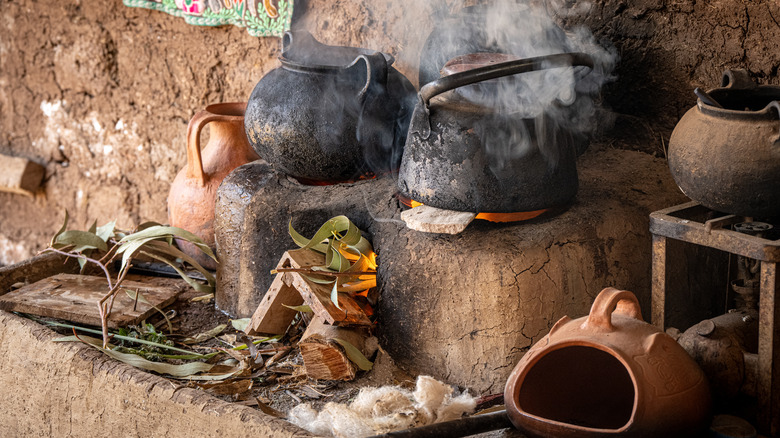What Seasonings Would You Find In A Medieval Spice Cabinet?
The old adage might be that "necessity is the mother of invention," but this sentiment certainly doesn't apply to the boom of the spice trade. Once the foodies of Medieval Europe got a taste of flavorful spices from the East, the ensuing Spice Mania was so intense that it literally prompted the official development of global trade routes by land and sea from Europe to the Mediterranean in the 1500s – the first routes of their kind. In this way, the demand for spices marked the beginning of international trade.
The most popular spice found in Medieval kitchens was pepper, followed by cinnamon, clove, ginger, and nutmeg (the unofficial warming spices). Also used were cardamom, cumin, anise, saffron, mace, coriander, turmeric, caraway, and mustard, but these were less common than the staple spices.
To Medieval foodies, both black and white pepper quickly became culinary fixtures, perfume ingredients, and home remedies for gout, arthritis, and even the Bubonic Plague (alongside thyme and mustard seed). Some hard-up folks were even known to trade peppercorns for rent instead of actual currency. Beyond pepper, ginger imported Westward from India and China was also in high demand. Cinnamon from Sri Lanka was paired with meats and burned as incense for religious rituals. Cloves imported from Indonesia were believed to promote dental health and also used to craft pomanders — fragrant clove-studded oranges displayed to ward off illness, and an enduring Martha Stewart holiday favorite today.
Pepper, ginger, cinnamon, and nutmeg sparked global trade between Europe and the Mediterranean
Per the lore, spices first arrived in the kitchens of Medieval European home cooks with soldiers returning from the Crusades in the Middle East. Since these spices were not suited to Europe's agricultural climate, they had to be imported from other countries — which also meant that, like written Medieval recipes, spices could only be enjoyed by folks wealthy enough to afford them and their steep shipping costs. According to the University of Toronto, buyers back in Europe were paying 10% to 100% more than what foodies in the East Indies were paying for the same product. Still, even though spices may have been a luxury item of the Silk Road, everyone from bourgeois lords to herdsmen and plowmen was noted to have bought spices, so firm was their grasp on Medieval European gastronomy.
Not only did spices dominate the European trade market from the 12th through the 17th centuries; they also served as a catalyst for broadened exploration. Once that 6,000-plus mile trade route was established, circling the Cape of South Africa, Medieval foodies were introduced to new flavors, inspiring a penchant for travel and spiking interest in the culinary styles of other countries. This heightened global awareness prompted travel – and, in many cases, subsequent colonization. Famed Medieval explorers Marco Polo of Italy and Ibn Battuta of Morocco embarked on voyages intended to accelerate the spice trade.
Medieval foodies heavily spiced their wines, sauces, and meats -- especially rabbit and boar
In Medieval kitchens, spices were utilized at the intersection of culinary arts and medicine. For instance, it was commonplace to eat heavily spiced foods in the winter months to aid in digestion and warm the body (hence the origin of the term "warming spices"). In the Medieval Ages, even the wine was spiced. Tournais-style Cameline sauce, a wildly popular accouterment to meat in 14th-century Paris, consisted of ground nutmeg, cinnamon, ginger, saffron, and breadcrumbs soaked in red wine and boiled to a reduction. Although, the liberal application of strong spices was also a notorious practice in Medieval Europe for masking the taste of spoiled meat, so any purported historical medicinal benefits should be taken with a grain of proverbial and literal salt (it's a preservative, after all!).
Classic Medieval dishes with heavy spices include pommeaulx (ground beef or pork meatballs with pepper, mace, cloves, cinnamon, and saffron) and egredouce (sweet and sour rabbit that evolved from the traditional French aigredoux). A recipe for Coney in Civey, or stewed rabbit with cloves, appears in the 1430 Northern English cookbook "Liber Cure Cocorum" ("The Art of Cookery"). Roast lamb in Cameline sauce, Steykes of Venson or Beef, and Bourbelier de Sanglier (wild boar loin in sauce) were also common spiced meat dishes on Medieval dinner tables.


